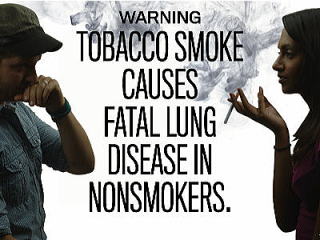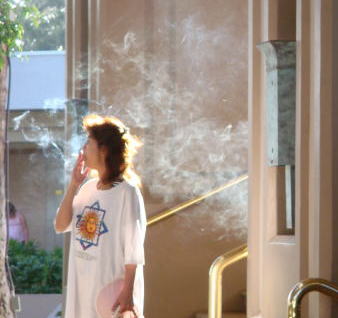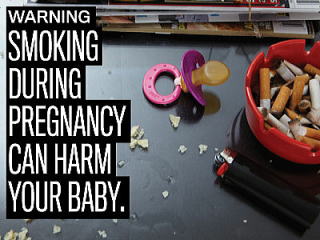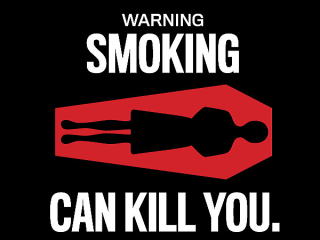 
平均10.3年の追跡期間で確認された浸潤性乳癌(がん)罹患者は計3,520人であった。タバコを吸っていた人、
今もタバコを吸っている人の乳癌発生リスクは、タバコを吸ったことのない人に比し、それぞれ9%、16%
上昇していた。高いリスクは喫煙歴の永い人、10代でタバコを吸い始めた人であった。乳癌の罹患リスクの
上昇は禁煙後も20年間持続した。タバコを吸わない人々について交絡因子で補正した場合、
受動喫煙の機会の多い女性★では、受動喫煙歴のない人たちに比し、32%の上昇が見られた。
★小児期で10年以上、成人期で自宅で20年以上、職場で10年以上
● Active and Passive smoking with the risk of breast cancer among women ●
Objective: To examine the association between smoking and risk of invasive breast
cancer using
quantitative measures of lifetime passive and active smoking exposure among
postmenopausal women.
Design Prospective cohort study. Setting: 40 clinical centres in the United States. Participants:
79990 women aged 50 to79 enrolled in the Women's Health Initiative Observational
Study during 1993
and 1998.
Main outcome measures: Self reported active and passive smoking, pathologically confirmed invasive
breast cancer.
Results: In total, 3520 incident cases of invasive breast cancer were identified
during an average of 10.3
years of follow-up. Compared with women who had never smoked, breast cancer
risk was elevated by 9%
among former smokers and by 16% among current smokers. Significantly higher breast cancer risk was
observed in active smokers with high intensity and duration of smoking,
as well as with initiation of smoking
in the teenage years. The highest breast cancer risk was found among women
who had smoked for 50 years
or more, compared with all lifetime non-smokers, hazard ratio 1.45, compared with lifetime non-smokers
with no exposure to passive smoking. An increased risk of breast cancer
persisted for up to 20 years after
smoking cessation.
Among women who had never smoked, after adjustment for potential confounders,
those with the most
extensive exposure to passive smoking had a 32% excess risk of breast cancer,
compared with those who
had never been exposed to passive smoking. However, there was no significant
association in the other
groups with lower exposure and no clear dose response to cumulative passive
smoking exposure.
Conclusions: Active smoking was associated with an increase in breast cancer risk
among postmenopausal
women. There was also a suggestion of an association between passive smoking
and increased risk of
breast cancer.
Source: British Medical Journal, March 2011
 イギリスの国営医療サービス事業「NHS」による市民に禁煙を促すTV-CM
イギリスの国営医療サービス事業「NHS」による市民に禁煙を促すTV-CM
“いつまでも若く見られたければタバコをやめなさい!”
 VIDEO VIDEO
Look younger for long, quit smoking.
 
Smoking During Pregnancy
If your health isn't enough to make you quit smoking, then the health of
your baby should be. Smoking
during pregnancy affects you and your baby's health before, during, and
after your baby is born.
The nicotine (the addictive substance in cigarettes), carbon monoxide,
and numerous other poisons
you inhale from a cigarette are carried through your bloodstream and go
directly to your baby.
Smoking while pregnant will:
- Lower the amount of oxygen available to you and your growing baby.
- Increase your baby's heart rate.
- Increase the chances of a spontaneous abortion and stillbirth.
- Increase the risk that your baby is born prematurely and/or born with low
birth weight.
- Increase your baby's risk of developing respiratory problems.
The more cigarettes you smoke per day, the greater your baby's chances
of developing these and
other health problems. There is no "safe" level of smoking while
pregnant.
How Does Secondhand Smoke Affect Pregnancy?
Secondhand smoke (also called passive smoke or environmental tobacco smoke)
is the combination of
smoke from a burning cigarette and smoke exhaled by a smoker. The smoke
that burns off the end of
a cigarette or cigar actually contains more harmful substances. These are
tar, carbon monoxide, nicotine, and
others. If you are regularly exposed to cigarette smoke, you increase your
and your baby's risk of
developing lung cancer, heart disease, emphysema, allergies, asthma, and
other health problems. Babies
exposed to secondhand smoke may also develop reduced lung capacity and
are at higher risk for sudden
infant death syndrome (SIDS).
Source:WebMD,
Cervical cancer risk roughly doubled with passive smoking.
Researchers have found that passive smoking can increase the risk of cervical
cancer by nearly the same
amount as active smoking and roughly double that of no smoke exposure.
Two studies revealed varied results,
and researchers believe that the true figure is somewhere in the middle.
They want more research done to
more accurately ascertain the risks of cervical cancer associated to passive
smoking. In 1963, the cervical
cancer risk increased by 2.1 times in passive smokers, 2.6 times in active
smokers, as compared to those
with no smoke exposure. In 1975, the cervical cancer risk increased by
1.4 times in passive smokers,
1.7 times in active smokers, respectively, as compared to those with no
smoke exposure. The combined
effects of exposure to active and passive smoking suggest its potential
adverse role in cervical carcinogenesis.
Source: summary of medical news story as reported by Cancer Page - Reuters
Health 23 Aug 2011
Smoking and smoking cessation in relation to mortality in women
Most of the excess risk of vascular mortality due to smoking in women may
be eliminated rapidly upon
cessation and within 20 years for lung diseases. Postponing the age of
smoking initiation reduces the risk
of respiratory disease, lung cancer, and other smoking-related cancer deaths
but has a little effect on
the other cause-specific mortality. These data suggest that smoking is
associated with an increased risk
of colorectal cancer mortality but not ovarian cancer mortality.

 Cigarette Smoking Increase Cervical Cancer Risk in Women Infected with
HPV Cigarette Smoking Increase Cervical Cancer Risk in Women Infected with
HPV
パピローマ・ウイルスの感染と喫煙との相乗発癌性
● 受動喫煙と女性の癌発生リスク●
タバコに多く含まれるニコチンは、皮膚に栄養を供給する毛細血管を収縮させるので、肌の乾燥が進み、
皮膚に細かい皺が出来やすくなります。そして、肌や髪、目などの老化を早めます。ニコチンはメラニン
色素代謝に関係するビタミンCを壊すため、肌の色が悪くなったり、シミなども出来やすくなります。

日本医師会作成ポスター
\女性に限らず、喫煙は口腔癌(がん)発生のリスク・ファクターであり、喫煙は唾液の分泌を抑制し、
ニコチンが歯根近くの毛細血管を収縮させるので、歯周病に罹り易くします。そして、タバコ特有の
強い口臭を放散し、相手の人に不快感を与えるのです。
・・ 自分では自分の口から発散される嫌なニオイに気づかないだけです。
WHO(世界保健機関)の統計によると、喫煙者は非喫煙者に比べ、3倍以上も不妊症になる確率が高い。
 
妊娠中の喫煙は、胎盤剥離、前置胎盤、流産、早産、死産になる確率を高めます。喫煙は
乳幼児突然死症候群(SIDS)の危険因子として知られています。喫煙は胎児への血流障害を起こす
ことにより、低体重児が生まれやすくなることも分かっています。低体重児は脳や体の発育上、問題を
残すこともあり、出生児の知能低下とタバコから放散されるタバコ副流煙とは高い関連性があると
考えられています。
喫煙は女性ホルモンのの代謝を阻害し、その分泌を低下させます。その結果、月経不順を引き起こし
たりします。喫煙は大切な卵巣への血流障害を引き起こすため、女性ホルモンを産出する卵巣の組織を
萎縮させ、閉経を早め、「女性としての寿命」を短縮くします。エストロゲン不足による骨粗鬆症になり
骨の密度が低下します。一日15本以上タバコを吸う女性は4倍の確率で骨折を起します。
喫煙によって細菌性膣炎の発症率が高まることも報告されています。タバコを吸っている女性のおりものは
悪臭のひどいことが多く、時として耐え難い場合があります。これはタバコの煙に含まれている
ベンゾピレン化合物が、膣内の酸性度を保って雑菌の繁殖を防いでいる乳酸桿菌を破壊することにより
引き起こされるからです。
子宮の入口にあたる子宮頸部の分泌物からも、タバコに含まれるニトロサミンなどの発癌物質が検出され
ています。今では子宮頸部癌と喫煙との関連は広く認知されております。無視できないことは受動喫煙
(他人のタバコの煙を吸うこと)により、喫煙していない女性に於ける子宮頸部癌の発生率が2倍以上にも
増加することです。

喫煙女性が禁煙しても肺癌、大腸癌死亡の危険性はすぐには消えない
JAMA(米国医師会学術誌)は米国の女性看護士を対象として1980年から2004年までの期間、喫煙と
死亡原因との関係を調査を掲載している。対象者は104,519人に及ぶ。現喫煙者の全死亡リスクは
非喫煙者に比べ、ハザード比、2.81であった。喫煙本数が多ければ多いほど、そのリスクは高まる。
ハザード比の高い疾患としてCOPD(慢性閉塞性肺疾患) 39.6、肺癌 21.1、
結腸直腸癌(大腸癌) 1.6 がある。肺癌リスクは禁煙後5年以内に死亡リスクは21%低下したが、
禁煙30年後でもゼロにはならなかった。大腸癌による死亡リスクは禁煙後20年で30%減少させる
ことが出来た。さいたま市立病院の館野博喜先生はタバコが「致死的流通品」であることが再確認
されたと述べている。
Source: Kenfield: Harvard School of Public Health 2008
 パピローマ・ウイルスの感染と喫煙との相乗発癌性 パピローマ・ウイルスの感染と喫煙との相乗発癌性
Cigarette Smoking Increase Cervical Cancer Risk in Women Infected with
HPV
 タバコと女性 厚生労働省制作ポスター タバコと女性 厚生労働省制作ポスター
※ 元の画面に戻るには ブラウザの(戻る) をクリックのこと をクリックのこと
 Active and Passive smoking with the risk of sickness among women Active and Passive smoking with the risk of sickness among women
女性に於ける喫煙の危険性
 2008年11月執筆 2010年11月タバコ警告画像添付 2011年12月改訂 医学博士、宮本順伯 2008年11月執筆 2010年11月タバコ警告画像添付 2011年12月改訂 医学博士、宮本順伯
★このサイトへのリンクは自由
The article was revised in December 2011, by Junhaku Miyamoto, M.D., PhD.
COPYRIGHT(C) 2006. JUNHAKU MIYAMOTO,M.D. ALL RIGHTS RESERVED
|
![]()
![]() Twitter@worldviewtokyo
Twitter@worldviewtokyo ![]() Twitter@smokefreejpn
Twitter@smokefreejpn ![]() Twitter@criticismjpn
Twitter@criticismjpn